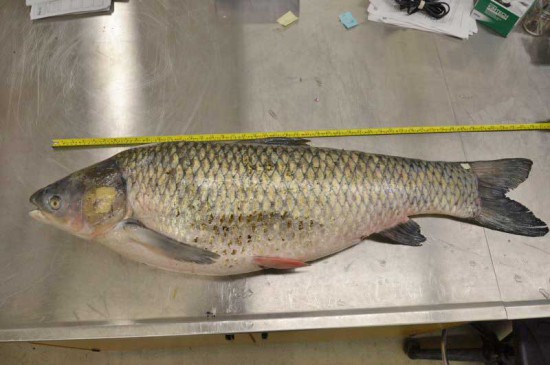LAKE HURON—Hot on the heels of news that the invasive grass carp (a species of Asian carp) has been found 23 times in the Great Lakes since 2012 (according to a joint report by Fisheries and Oceans Canada [DFO] and the Great Lakes Fishery Commission), the Michigan Department of Natural Resources (DNR) has launched a global challenge to find a solution to the scourge that is the Asian carp. A hefty reward is the prize for a practical solution.
According to the DFO website, “there have been a few rare captures of individual bighead carp and grass carp in the Canadian waters of the Great Lakes. Of the bighead carp, only three specimens have been collected, all in western Lake Erie, between 2000 and 2003, which are believed to have been intentionally released. Of the grass carp specimens, there have been approximately 23 single captures since 2012 in the waters of Lake Huron, Lake Ontario and Lake Erie (the most recent one in 2016). Of those tested, nine were found to be fertile. No silver carp or black carp have been found in the Great Lakes.”
The website goes on note that juvenile grass carp have been found in the Sandusky River in Ohio, which empties into Lake Erie. These fish are said to have been produced by natural reproduction.
Joanne Freeman, invasive species communications coordinator with the Michigan DNR, explained that the ‘Michigan Invasive Carp Challenge’ came out of Michigan Governor Rick Snyder’s ‘State of the State’ address in January. In the address, the governor promised $1 million toward the global challenge (yes, Canadians can enter) to find a solution, or solutions, to stopping the spread of invasive carp in the Great Lakes.
As we now know that grass carp have found their way into the Great Lakes basin, Ms. Foreman said she hopes the challenge finds solutions to dealing with the big head and silver carp—the most voracious of the Asian carp species when it comes to feeding and reproductive capacity. These two species are now living within 16 kilometres of the three electric barriers built to prevent Asian carp from entering the Great Lakes through the Chicago Area Waterways System, according to the Michigan DNR website. Should the fish make their way through those barriers, it would be devastating to the Great Lakes eco-system and could mean the end of a $7 billion fishing industry.
Asian carp were intentionally introduced into farmed catfish enclosures in the southern United States in order to assist catfish growers by cleaning these commercial ponds. Escapees made their way into the Mississippi River and its tributaries and are now close to Chicago and perilously close to Lake Michigan.
Ms. Foreman said she has already fielded a call from at least one Canadian who is hoping to put their ideas into the game
The Michigan DNR has partnered with InnoCentive—a global crowdsourcing leader that has undertaken more than 2,000 crowdsourcing projects across the world. “This helps us ensure valid responses,” Ms. Foreman explained, “and this is how solvers can access the challenge.”
The InnoCentive page for the Michigan Invasive Carp Challenge is not yet up and running but until then the DNR encourages ‘solvers’ to register on the Michigan DNR website (michigan.gov/carpchallenge). They will be informed once the InnoCentive page is ready for their submissions—likely this summer.
In the meantime, Ms. Foreman said she and the rest of her team will be spreading the word on what can be done and what has been done to help stop the spread of Asian carp on both sides of the border, and all the complexities that are involved.
The Michigan DNR has not yet decided on an end date to the challenge.
Ms. Foreman promises that the solutions chosen by her government will come with a hefty monetary prize—in US dollars.
For more information, or to sign up, visit www.michigan.gov/carpchallenge.



